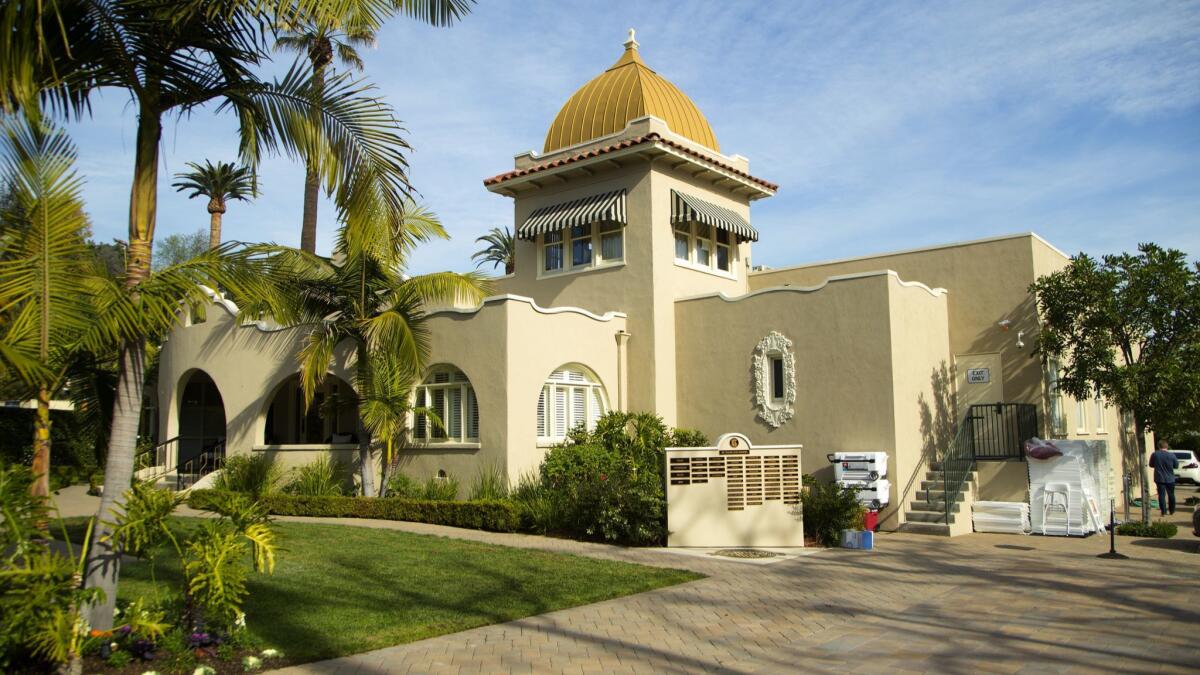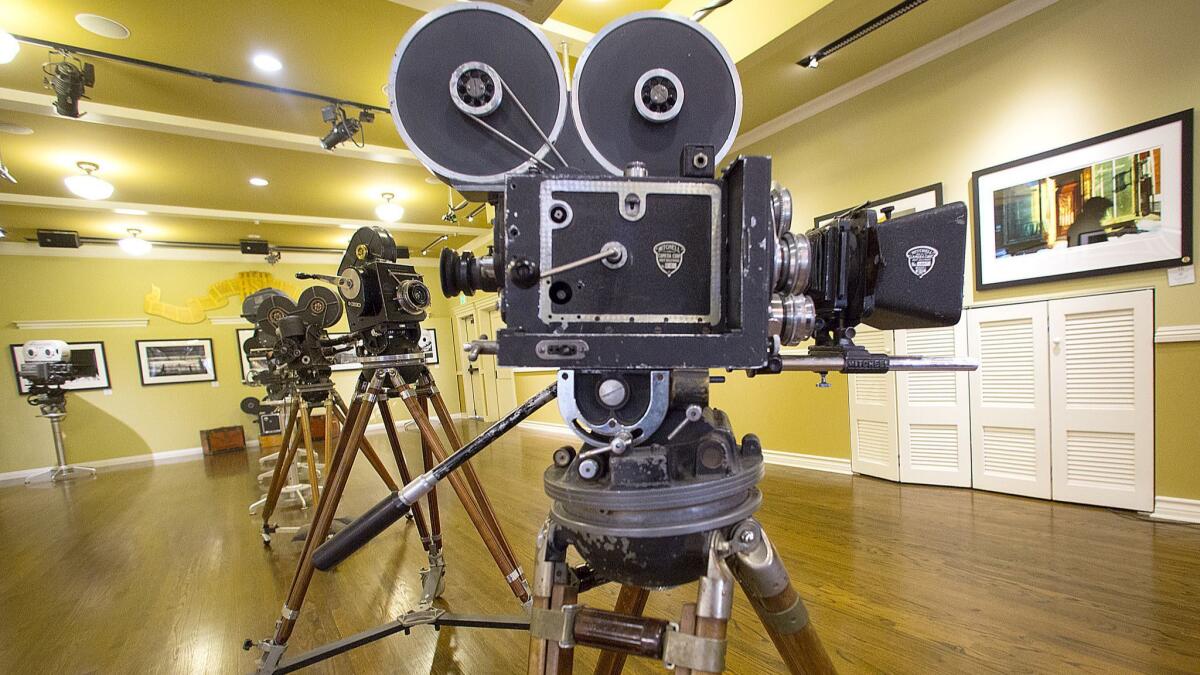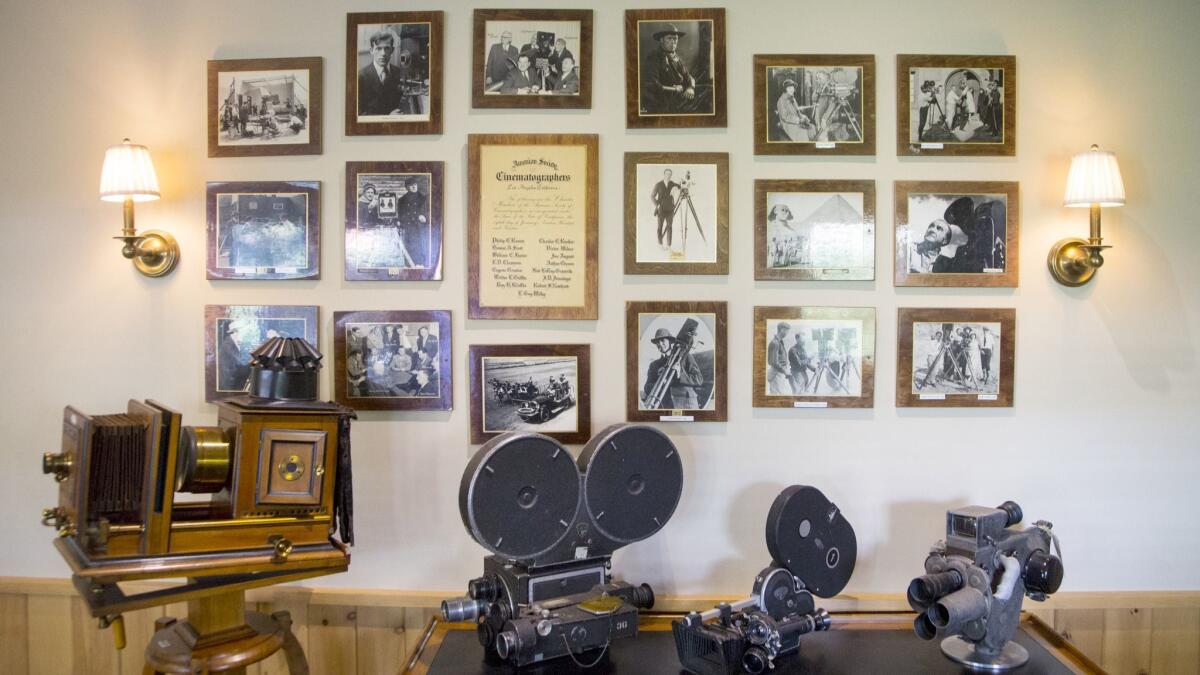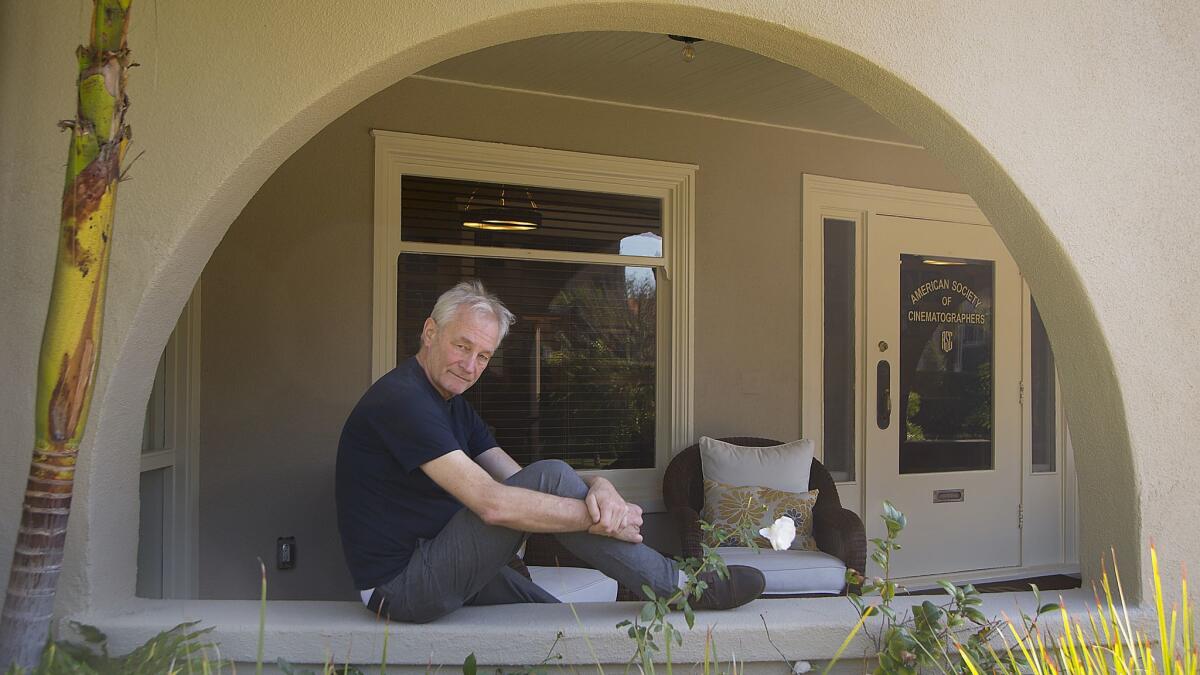At 100, the American Society of Cinematographers looks back while thinking ahead

- Share via
From the street it’s a Mission-style California bungalow. A remnant of old Hollywood. It was built as a model home in 1895, with a “fantasy tower” rising out of the top to tempt potential buyers with its then-unobstructed view. But like the organization it houses, the building near Hollywood and Highland is deceptively old-school in front while looking to the future inside.
Since 1937, it has been the official clubhouse of the American Society of Cinematographers, which turns 100 this month.
“We’re a society, not a union or guild,” notes ASC third-term President Kees van Oostrum. “Their main purposes are labor situations, insurance, pension, health and welfare. We stay away from all that.
“When the ASC formed in 1919, they said, ‘We just want to be a social club that also deals with the art of cinematography.’ Yes, they had a pool table, they had a player piano, but they were adamant about educating directors and producers about what a cameraman really did.”
Today, the society publishes the magazine American Cinematographer, and educates and consults the industry on new technology.
Membership is by invitation only. “There are no quantity or age requirements. Membership is judged entirely by accomplishment, looking at excellence in the art and craft of cinematography,” says ASC spokeswoman Lisa Muldowney.

Bylaws require candidates to have been directors of photography for at least five of the last eight years. Once a member sponsors a candidate, the membership must ratify the quality of that person’s work by vote. It’s an exclusive club: While the International Cinematographers Guild represents about 8,400 professionals, the ASC has only 390 active and retired members (plus 230 associates). That includes what Van Oostrum estimates to be a 5% increase each year in recent times.
Having the ASC designation after cinematographers’ names has become a point of prestige and authenticity — a seal of approval that’s invaluable especially as women and minorities establish themselves in a traditionally white, male field.
Rachel Morrison is the only woman so far to be nominated for the cinematography Oscar, for 2017’s “Mudbound.” Morrison, who was the cinematographer on “Black Panther,” notes that, “Especially among female cinematographers, there’s a real tendency for people to doubt one’s experience level or abilities. Those letters tend to legitimize one as knowing what they’re doing.”
A number of events are marking the ASC’s centenary: a proclamation by the city, an open house for the public and a members-only celebration at the clubhouse.
This is no ordinary clubhouse. On a recent private tour of the society’s home, Van Oostrum points out the camera that shot “Bullitt,” another that captured several Alfred Hitchcock features, including “North by Northwest,” and the Mitchell BNC Serial Number 2, which Gregg Toland used to shoot “Citizen Kane.”
There are beautiful still photographs by members on the walls and a kitchen stocked with K-cups and pastries. Then, smiling, he adds, “We have a bar … obviously.”

RELATED: How the American Society of Cinematographers is dealing with diversity »
Five-time Oscar nominee Caleb Deschanel (“The Black Stallion,” “The Natural,” the upcoming “The Lion King”) joined in the ’80s. He says members “learn from each other, share stories about productions and everything. There’s a big educational aspect to it as well. They run these programs for students to talk to cinematographers.”
About 1,600 students have earned certificates under the tutelage of top shooters via the ASC’s “Master Classes,” notes Van Oostrum.
Indicating a modern-looking structure coming together behind the building’s history-preserving face, he explains: “That’s where the new Education Center will go.” It’s a fitting metaphor for the organization. Through its Motion Imaging Technology Council (MITC, or “My Tech”), the ASC has counseled the industry on many aspects of image capture, reproduction and theatrical exhibition and home distribution. It led the standardization of color grading from device to device and format to format — all to preserve filmmakers’ intentions.
Sometimes that can seem a little like moving forward to go back: Van Oostrum proudly says the organization was instrumental in getting home-video manufacturers to provide settings for viewers to tone down digital “motion smoothing” (causing what some call the “soap-opera effect”) to restore films to their cinematic look. He also champions shooting on film, calling it a “myth” that digital productions are cheaper.
Deschanel acknowledges the importance of the organization staying in the technological forefront. “When the ASC was formed, motion picture cameras were basically Bell and Howell Cameras … 35-mm film was used to make movies,” he says. “That didn’t change for almost 100 years. The big changes that happened in the first 100 years were basically color, with first two-strip, then three-strip; then once color film was developed, the big changes had to do with speeds of film and grain and emulsion and things like that. Suddenly, in the last 15-20 years, with the evolution of digital technology, everything is changing.
“There’s a lot of technical talk,” Deschanel adds. “But what really interested me was the conceptual talk about how you come up with an idea for representing the story on film.”
It’s this kind of discussion about the art and science of cinematography that makes the ASC special, members say.

There’s always been this sort of law here that once you come through these doors, we’re all even.
— ASC President Kees van Oostrum
“There’s always been this sort of law here that once you come through these doors, we’re all even,” notes Van Oostrum, whose shooting career began in 1980. “I’ve been a member for 26 years. Even in the old days, when I was smuggled in — I wasn’t supposed to be here as a student — they would deal with me as an up-and-coming cinematographer. You could ask anything.”
Polly Morgan (“Call the Midwife,” “Legion”), at 39, became the ASC’s youngest member this summer, according to the organization. “I’ve been there in social situations where I’ve gotten to have a drink with some of the people whose work I’ve seen but I didn’t know personally. Now we have a sort of personal connection.”
She recalls shooting an ASC project featuring Deschanel: “Since I was a little girl, ‘The Black Stallion’ has been one of my favorite films. So to meet Caleb was a real honor.”
Larry Fong (“300,” “Now You See Me”) says he’s too shy, generally, to approach admired artists, but is fired up by learning:
“There are times when I go to the movies and think, ‘How could they do a movie of this scope?’ Or if not the scope, subtle beauty. I’m often baffled by how someone captured an image, lit something, or thought of a camera move. I don’t have everything figured out; I’m always learning. It’s an evolving art.”
Morrison, who joined in 2017, says she has received “an incredible amount of support from within the society. I can’t tell you how many of my heroes approached me to tell me how personally moved they were by my work on ‘Mudbound.’
“That was incredibly meaningful to me.”
------------
The ASC Clubhouse
Where: 1782 N. Orange Drive, Los Angeles
When: Open to the public by appointment on weekdays during normal business hours.
Info: (323) 969-4333
More to Read
Only good movies
Get the Indie Focus newsletter, Mark Olsen's weekly guide to the world of cinema.
You may occasionally receive promotional content from the Los Angeles Times.











